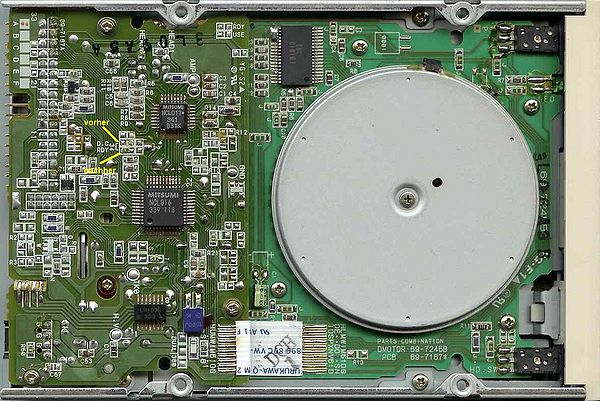Difference between revisions of "Modify PC floppy drives"
(Clarify the DC/RDY selector) |
|||
| (4 intermediate revisions by 3 users not shown) | |||
| Line 13: | Line 13: | ||
== Mitsumi D359T3 == | == Mitsumi D359T3 == | ||
| − | There is a small SMD resistor on the back of the circuit board marked with | + | There is a small SMD resistor on the back of the circuit board marked with '''D.C.''' (Disk Change). |
| − | Next to it is an empty solder pad marked with '''RDY'''. Desolder the resistor and move it to the RDY-Position. The drive now | + | Next to it is an empty solder pad marked with '''RDY''' (Ready). Desolder the resistor and move it to the RDY-Position. The drive now outputs a Ready signal instead of a Disk Change signal. |
Additional information and pictures at [http://www.sax.de/~zander/bic/bic_tip.html] (german, but at least the picture is helpful) | Additional information and pictures at [http://www.sax.de/~zander/bic/bic_tip.html] (german, but at least the picture is helpful) | ||
| Line 35: | Line 35: | ||
Break the connection between PIN1 and the small chip nearby. | Break the connection between PIN1 and the small chip nearby. | ||
| − | [[ | + | |
| + | == Other Links == | ||
| + | [[Drive Compatibility]] Local article about CPC-compatible drives | ||
| + | |||
| + | [http://www.pitsch.de/stuff/amiga/floppy.htm Enabling the Ready Signal] - German Site with instructions and photos of how to enable the ready signal for many common floppy drives. | ||
| + | |||
| + | |||
| + | |||
| + | [[Category:DIY]][[Category:DATA Storage]][[Category:Non CPC Computers]] | ||
Latest revision as of 05:49, 20 December 2022
This document explains how to modify some PC floppy drives to output a RDY-Singal. This signal is required by the CPC for best compatibility.
Contents
Samsung SFD-321B
This is my (SpaceRat) choice, as it was possible to buy this drive new right away from normal computer stores at least in 2006.
You need to remove the shield on the bottom of the drive first. On the circuit board, just below the red+black+white cable to the motor, you will find two soldering bridges labelled DC and RDY, with a zero Ohm SMD-resistor on the "DC" bridge. Unsolder it there and resolder it on the bridge labelled "RDY".
The Samsung SFD-321B is also hardwired to HD-disks (High Density), we will need to change this to DD (Double Density):
Also on the circuit board, right behind the push button, you will find an empty space labelled SW1, next to it is a soldering bridge labelled C16, destroy the connection it makes by unsoldering it and/or scratching away the soldering tin between the two points. The drive will now "see" all 3½" disks as DD, regardless of their actual specifications, so as long as you only use the disks on the CPC, you don't even need to close the HD-index-hole, though you will still need to do this on your PC. This peculiarity of this drive also means that you probably don't want to have it in your PC, as you probably wouldn't want to modify your PC drive to DD-only just to be able to exchange disks between CPC and PC. So before you go and buy a Samsung SFD-321B for your CPC, check your PC first and if there is the Samsung inside, get a new, non-Samsung, for your PC instead, using the existing Samsung for your CPC.
Mitsumi D359T3
There is a small SMD resistor on the back of the circuit board marked with D.C. (Disk Change).
Next to it is an empty solder pad marked with RDY (Ready). Desolder the resistor and move it to the RDY-Position. The drive now outputs a Ready signal instead of a Disk Change signal.
Additional information and pictures at [1] (german, but at least the picture is helpful)
Mitsumi D359T5
see the section about the D359T3
Mitsumi D359T6
see the section about the D359T3
NEC FDH1231H
Join PIN1 on the flat cable connector with test point 15 (TP15), located under the black sticker.
Break the connection between PIN1 and the small chip nearby.
Other Links
Drive Compatibility Local article about CPC-compatible drives
Enabling the Ready Signal - German Site with instructions and photos of how to enable the ready signal for many common floppy drives.
